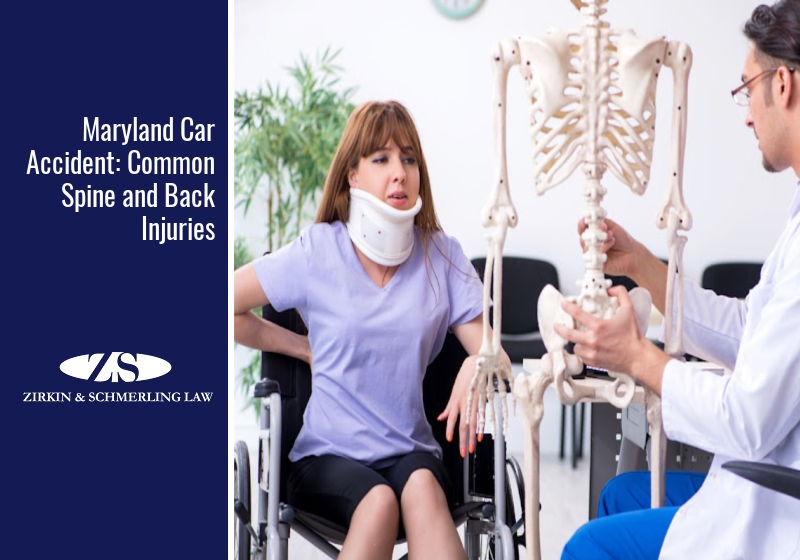
If you are someone who never consciously thinks of your spine or back, congratulations. The spine is the body’s central structure of support and connects the various parts of your musculoskeletal system together. You need it to complete almost every movement you make, such as sitting, standing, twisting, and bending (not to mention digging, diving, and dancing). Unfortunately, many Americans experience pain on a daily basis — or even partial or complete paralysis as a result of back and spine injuries.
Back injuries from car accidents can occur depending on where the car was struck and the speed of the vehicles involved. These are listed below in order of severity:
- Whiplash: When the neck (this is technically a part of the spine called the cervical spine) snaps back and forth in a collision, it causes trauma to the soft tissues. You may not feel the effects until the day after your auto accident, but then you could experience such symptoms as:
- Pain
- Difficulty moving your neck
- Dizziness
- Headaches
- Numbness or tingling in your arms
- Herniated disc (also called a ruptured or bulging disc): This occurs when the soft center of a disc protrudes out, placing pressure on surrounding nerves. These usually occur in the lower back, but can also occur in the neck. Herniated discs cause such symptoms as:
- Arm or leg pain (a sharp, burning pain)
- Numbness or tingling
- Weakness
- Vertebral fractures: Enough force in a MVA (motor vehicle accident) can fracture one or more vertebrae. This could cause the spinal cord to be pinched or even severed.
- Burst fractures: The vertebra is fractured in several places and possibly tiny pieces of it embed themselves in the spinal cord.
Symptoms of burst fractures include:
- Moderate to severe back pain (made worse by moving)
- Numbness, tingling, and weakness
- Difficulty or Inability to empty bowel or bladder (when spinal cord is involved)
- Flexion/Distraction fractures: These occur in head-on collisions where the top of the body is propelled forward while the seat belt holds the lower part of the body in place. The vertebrae are torn apart.
Symptoms of flexion/distraction fractures include:
- Pain
- Possible spine deformity
- Gastro-intestinal injuries (as a result of the way the injury happened)
- Fatigue
- Vertebral compression fractures (VCF): These can occur after accidents when part of the spine collapses (compresses). They generally occur in the lower part of the middle spine (thoracic spine).
According to the NSCSC (National Spinal Cord Injury Statistical Center), approximately 291,000 people in the United States live with spinal cord injuries. Causes of back injuries from car accidents varied, but motor vehicle crashes top the list.
Causes of spinal cord injuries since 2015
- Vehicle accidents 39.3%
- Falls 31.8%
- Violence (mainly guns) 13.5%
- Sports 8.0%
- Medical/Surgical 4.3%
- Other 3.1%
The spinal cord is a collection of nerves and nerve tissue that runs from the base of the skull to the bottom of the back. It is covered by membranes and surrounded by the vertebrae, which are made of bone. When the spinal cord is damaged, it may be complete or incomplete.
Complete: All feeling and motor function are lost below the place where the spinal cord is injured.
Incomplete: There is partial feeling or motor function below the spinal injury.
The types of testing hospitals will do after a MVA where these types of injuries are suspected include:
CT scans (computerized tomography): These can show soft tissues, blood vessels, and bones
MRIs (magnetic resonance imaging): These use magnets, radio waves, and computers to take detailed pictures.
Evoked potential testing: These tests measure the time it takes for nerves to respond to stimulation.
As you can imagine, any injury to the back and spine can be painful, debilitating, and expensive, to say the least. For example, hospital stays are an average of 11 days. The first year of expenses after a high tetraplegia (all four limbs affected) spinal cord injury averages $1.079 million (as of 2017).
In 2019, there were 115,926 motor vehicle collisions in Maryland. Fully 30% of these accidents resulted in injuries, including spine and back injuries. The last thing you or your family need to do while you are recovering or dealing with a catastrophic injury is to handle an unwilling or argumentative insurance company or to deal with the intricacies of a lawsuit alone.
You need an experienced car accident lawyer who can fight for full compensation for you if you have injured your back and spine in a motor vehicle accident. At Zirkin & Schmerling Law, we have worked with individuals and families who are dealing with all types of spine injuries, including the traumatic impact of sudden crash-related paraplegia and quadriplegia. These are life-altering injuries that create mobility challenges, cause financial strain, and change family dynamics.
A life-altering injury deserves the highest level of attention to detail from an excellent personal injury lawyer. The team at Zirkin & Schmerling Law can help you pursue a high-value claim that allows you to stop worrying about the financial side of your situation and focus on your health.
Have a Legal Question? We Have Answers
When you need to learn more about your rights, the attorneys at Zirkin & Schmerling Law can help. Contact us or call us at (410) 753-4611 to set up an appointment with one of our experienced car accident lawyers today.
